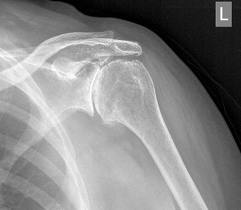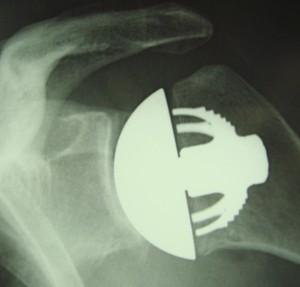Most of you reading this will be aware that surgeons can replace a worn out hip or knee joint with a new one made of metal or plastic or ceramic. What you probably aren’t aware of is that we can do exactly the same for a painful, worn out, arthritic shoulder. In fact we have been replacing shoulders for much longer than hips or knees.
How do I know if my shoulder pain is due to arthritis?
The older you are then the greater the chance that if you have a stiff, painful shoulder that it is due to arthritis – especially if you can hear it creaking when it moves.
I do have a stiff shoulder but my GP and my therapist both told me it was a Frozen Shoulder. Could they be wrong?
Oh they can very easily be wrong and, sadly, one of the biggest problems we see is the older person being wrongly diagnosed with a Frozen Shoulder when, in fact, it is arthritic and is not going to get better in the way a Frozen Shoulder does.
To diagnose a Frozen Shoulder you have to have an x-ray. Those are the rules and no-one should accept that diagnosis without having had one.
Will an x-ray tell me if I have arthritis?
Yes it will. It’s an easy test to get done and is pretty sensitive for picking up arthritis.
Well it’s a bit stiff and a bit painful but I can cope with it. I don’t have to have a new one do I?
Of course not. You will know when the time is right for a new one because the painkillers won’t be doing their job any more or you will have lost so much function that you can’t use the arm the way you would like to and it is making life a misery. When you reach that point it will be quite an easy decision to make.
My shoulder is like that. I can’t sleep; I can’t do the garden; I can’t do my sports. I’ve had enough of the pain. Tell me about a new shoulder joint.
What happens in arthritis is that the smooth lining of the joint – tbe articular cartilage – wears away and there is bone rubbing and grating against bone. So what I need to do is put in a new joint.
It’s not metal on metal like those hips is it?
No. It’s not! Shoulder replacements are metal on plastic which are the same materials as have been used very successfully in hips that have lasted 40 years or more. There are also some shoulders made of ceramic and a fancy new one I use on some patients made of Pyrocarbon (see Pyrocarbon Shoulder Replacement). So we haven’t had any of the problems the hip surgeons have had and we don’t envisage there being any in the future.
Do you replace the ball and the socket? I have heard that some people just get half a shoulder.
You are right. And most of my patients just get half a shoulder – what is technically called a hemi-arthroplasty – where I replace the ball (humeral head) and leave the socket alone (glenoid)
Why?
Well the humeral head has to be replaced and we’ve got pretty good at that with designs that are an exact match for your size and shape. And we are able to attach the new ball to the bone without having to use cement (the glue that bonds them together) which we know is a potential source of weakness and loosening. So we think we have the ball bit but sorted out and a new humeral head replacement should last a lifetime without wearing out or loosening.
And the socket?
We aren’t so good at that and we really don’t have a guaranteed way of replacing the glenoid with an implant that won’t loosen or wear away. Research shows that the glenoid is the weakest link in a shoulder replacement.
So the half shoulder replacement is fine then?
There is a potential down side to that too. If I don’t replace the glenoid then there is a chance that the metal ball can rub or erode the glenoid and cause pain. And if that happens I may have to go back in and put in a glenoid – although in all my years of doing half-shoulders I haven’t had to do that yet.
So I have to balance the risks of doing a total shoulder replacement (ball and socket) where the glenoid could wear out or come loose and have to be replaced against the risk in a hemi-arthroplasty (ball only) of the glenoid eroding and I have to go back in and put in a glenoid.
And for me the statistics favour the hemi-arthroplasty because its risks are lower than those in a total shoulder and the results, in my hands, are just as good.
So why does anyone do a total shoulder replacement?
There is some evidence that there is slightly better pain relief and movement with a total. However in my experience that is not the case so when I balance everything out in the way I do things and how my patients do then I am very happy with a hemi. And you will be too!
Is there anything else you can try before I go for the big operation?
I have to be sure that the arthritis seen on the x-ray is the cause of your pain and stiffness. If you have a very bad shoulder (a lot of pain and not moving much) then the arthritis is very clearly the culprit. Sometimes, though, when the arthritis is not so severe, it may be that some of the pain is coming from other parts of the shoulder such as the rotator cuff or the ACJ or the biceps tendon. So it may be worth eliminating those bits from the equation first with a keyhole operation and only replace the shoulder if the pain persists after that.
So, if you have a stiff, painful shoulder that is making your life a misery then a new one can be the answer.



